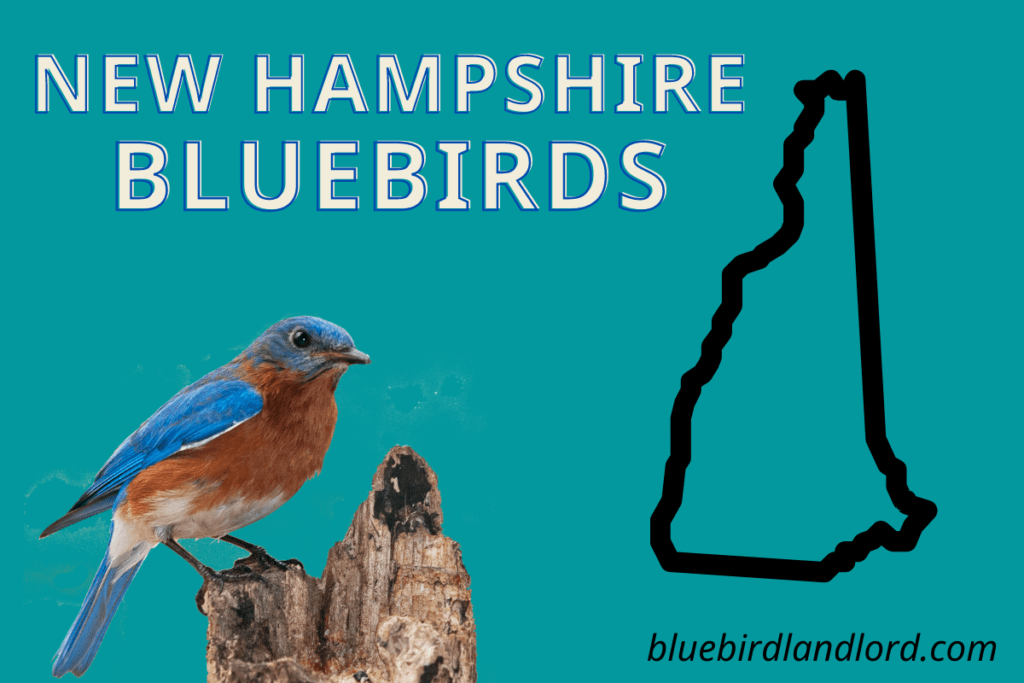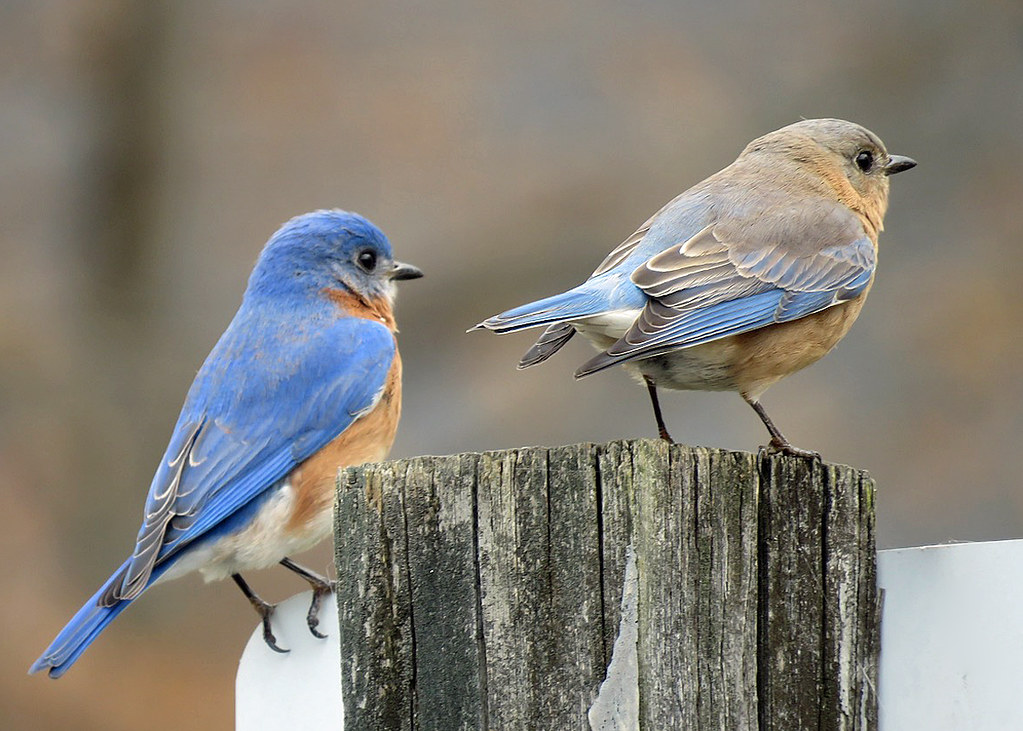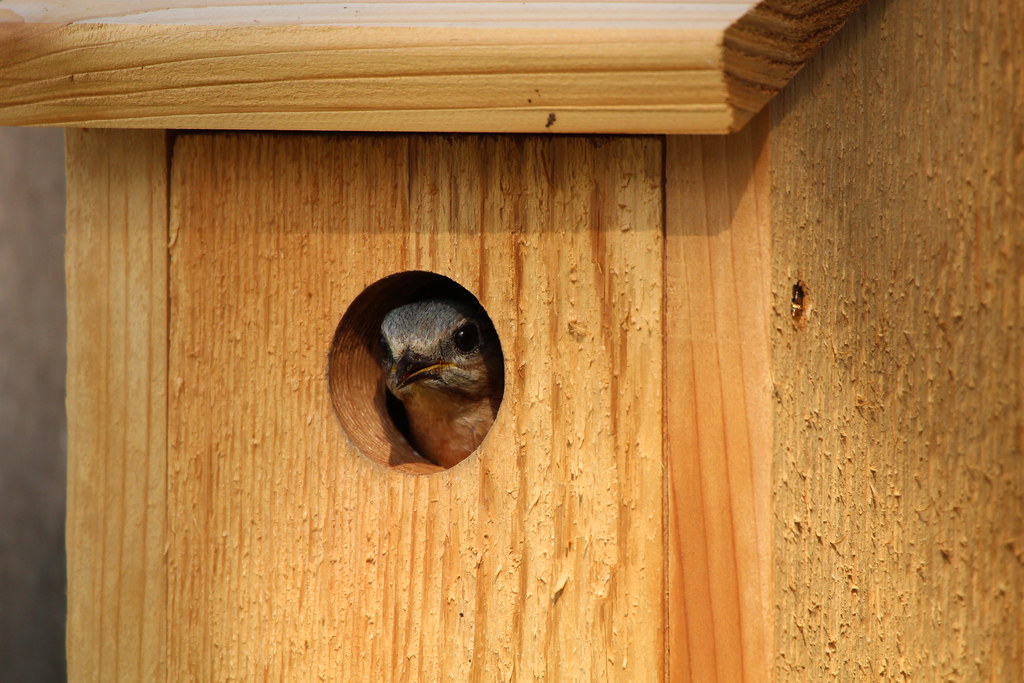
Bluebirds are one of North America’s most beloved songbirds. Luckily, bluebirds can be found in almost every one of the fifty US states, including New Hampshire. For anyone living in New Hampshire who is interested in bluebirds, I wanted to create a hub of bluebird-related information for you. This is your ultimate resource for Bluebirds in New Hampshire!
Contents
- What Kind of Bluebirds Are Native to New Hampshire?
- Where to See Bluebirds in New Hampshire
- Similar Birds
- How to Attract Bluebirds
- Feeding Bluebirds
- What Nest Box Should I Use for Bluebirds in New Hampshire?
- Get Involved In Bluebird Conservation
- New Hampshire Bluebird Conservation Organizations
- How to Report Your Bluebird Fledglings in New Hampshire
- New Hampshire Bluebird FAQs

Photo by Kelly Colgan Azar is licensed under CC BY-ND 2.0
What Kind of Bluebirds Are Native to New Hampshire?
There are three species of bluebirds that live in the United States, but the Eastern Bluebird is the only species found in New Hampshire. Eastern Bluebirds find their home in New Hampshire and in other states east of the Rocky Mountains. They are frequently seen in open areas, like fields and backyards, where they have plenty of space to hunt for insects. Setting up a bluebird nest box is one of the best ways to attract Eastern Bluebirds to your yard.
Eastern Bluebird Fast Facts
| Latin Name | Sialia sialis |
| Habitat | Grasslands, open fields, countryside |
| Food | Mostly insects – typically crickets, caterpillars, spiders, beetles |
| Nest Type | Secondary-cavity nesters – old woodpecker holes, dead trees, nest boxes |
| Nest Description | Dry grasses, animal hair, pine needles |
| Egg Description | 3-5 pale blue (or sometimes white) eggs |
| Conservation Status | Low Concern |

Photo by 611catbirds, too is licensed under CC BY 2.0
Where to See Bluebirds in New Hampshire
As a general rule, you can find bluebirds in New Hampshire in many open places out in the country. They typically live in places with scattered trees, fence rows, open fields, and where old woodpecker holes or nest boxes are available for nesting.
Common places to find bluebirds in New Hampshire:
- Open fields
- Backyards
- Golf courses
- Fence posts
- Telephone wires
- Cemeteries
Similar Birds to Bluebirds in New Hampshire
Blue Jays and Indigo Buntings are blue-colored birds that are often incorrectly called “bluebirds.” However, they are different species entirely. Blue Jays are much larger blue-colored birds found throughout much of the eastern and central United States. Indigo Buntings are smaller, but rarer, blue-colored birds that people also confuse with Eastern Bluebirds.
Species: Blue Jay

Photo by U. S. Fish and Wildlife Service – Northeast Region is marked with CC PDM 1.0
Species: Indigo Bunting

Photo by Kelly Colgan Azar is licensed under CC BY-ND 2.0
Learn more about how to differentiate between Eastern Bluebirds and Indigo Buntings in this article that I wrote here.

Photo by ibm4381 is licensed under CC BY 2.0
How to Attract Bluebirds in New Hampshire
The best way to attract bluebirds in New Hampshire is to put up a nest box in an open area. Since bluebirds are secondary-cavity nesters, they make use of old woodpecker holes, natural tree cavities, and nest boxes to build their nest. They cannot build nests in trees like robins, cardinals, or many other birds.
If you have a medium to large sized backyard in the country, consider putting up a bluebird nest box! If you set up a bluebird house in the middle of February, you could have a nesting pair of bluebirds by early spring.
Learn everything you need to know about attracting bluebirds in the article that I wrote here: How to Attract Bluebirds.

Feeding Bluebirds
If you have already spotted bluebirds in your area, you can also train them to come to a bird feeder. However, they won’t eat the same seeds that you might put out for other birds. At a bird feeder, bluebirds enjoy live mealworms, especially during the summer when insects make up the majority of their diet. During the winter, when insects become scarce, you can attract bluebirds to your feeder with sunflower seed hearts, berries, pieces of fruit, chopped peanuts, and peanut butter. For bluebird feeding tips, check out these articles I wrote here.
What Nest Box Should I Use for Bluebirds in New Hampshire?

Photo by Dolan Trout is licensed under CC BY 2.0
The best nest box to use for bluebirds in New Hampshire is either (1) a wooden nest box with a 1 1/2 inch round entrance hole, or (2) a Gilbertson-style PVC pipe nest box with a 1 1/2 inch round entrance hole. Each of these nest box styles work well for Eastern Bluebirds and they have proven successful at attracting bluebirds in New Hampshire.
You can compare these two nest box styles on my Recommended Tools page here.
If you already have a bluebird house at home, make sure that it has a round entrance hole that is exactly 1 1/2 inches in diameter. If the hole is too small, bluebirds won’t be able to enter the nest box. But, if the entrance hole is too large, it may allow European Starlings to enter, which are an invasive species that compete heavily with bluebirds for nesting sites. So, make sure your bluebird house is built to the proper size. Learn more about entrance hole size in this article here.
Get Involved With Bluebirds in New Hampshire
If you want to get involved with bluebird conservation in New Hampshire, the best thing you can do is to become a bluebird landlord. What is a bluebird landlord? A bluebird landlord is someone who attracts and cares for bluebirds by providing a safe place for them to nest.
Setting up a bluebird nest box and providing a safe place for bluebirds to nest in your backyard will go a long way. I wrote an article called 10 Steps to Become a Bluebird Landlord. Read that article and get started attracting bluebirds to your backyard today!
Bluebird Conservation Organizations in New Hampshire
The state of New Hampshire does not have any active bluebird conservation organizations. However, the North American Bluebird Society is the nationwide organization in the US that promotes the conservation and care of bluebirds.
Go to the North American Bluebird Society website here for more information.
How to Report Your Bluebird Fledglings in New Hampshire
Since New Hampshire doesn’t have an official bluebird conservation organization, you can report your annual number of bluebirds fledglings online at NestWatch.org, a website of the Cornell Lab of Ornithology. Click this link to report your yearly bluebird fledglings online.
Frequently Asked Questions
Do bluebirds winter in New Hampshire?
As a general rule, bluebirds can be found in New Hampshire all winter long. The mild winters of recent years have led to more winter bluebird sightings. In some areas of far northern New Hampshire bluebirds do migrate south for the winter because of the colder weather. For this reason, Eastern Bluebirds are considered “partial-migrants” (source).
Conclusion
Eastern Bluebirds are one of North America’s most beloved birds. With their strikingly blue color, their gentle song, and their preference for the quiet countryside, bluebirds often evoke a sense of peace and nostalgia for New Hampshire residents.
If you are interested in attracting Eastern Bluebirds to your own backyard, learn how you can do that by reading my article called How to Attract Bluebirds.
Which species of bluebird lives in your state? Click here to find out what species of bluebirds to look for in all fifty US states.

